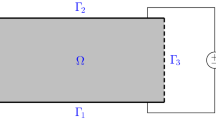Abstract
A two-dimensional model of the Frederiks effect is used to investigate the static electric field effect on the orientation of the nematic liquid crystal (LC) director in a side-electrode cell. The solutions are obtained by the standard finite-difference methods. The programs for the numerical solution of a two-dimensional parabolic partial differential equation are developed both in FORTRAN and C/C++. The Frederiks transition threshold for the central part of the cell and the dependences of the director’s orientation distribution on a high electric field are obtained. The results of the calculation are compared with the experimental data.
Similar content being viewed by others
References
I. C. Khoo, Liquid Crystals, 2nd ed. (Wiley Interscience, New York, 2007).
L. M. Blinov, Electro–and Magnetooptics of Liquid Crystals (Nauka, Moscow, 1978) [in Russian].
P. de Gennes, The Physics of Liquid Crystals (Clarendon, Oxford, 1974).
S. Chandrasekhar, Liquid Crystals (Cambridge Univ. Press, Cambridge, 1977).
N. Bloembergen, Nonlinear Optics (Benjamin, New York, 1965).
M. Born and E. Wolf, Principles of Optics (Pergamon, London, 1959).
J. Li, C. H. Wen, S. Gauza, R. Lu, and S. T. Wu, “Refractive indices of liquid crystals for display applications,” IEEE J. Display Technol. 1, 51–61 (2005).
P. D. Maker, R. W. Terhune, M. Nisenoff, and C. M. Savage, “Effects of dispersion and focusing on the production of optical harmonics,” Phys. Rev. Lett. 8, 21–23 (1962).
F. Lonberg, S. Fraden, A. J. Hurd, and R. E. Meyer, “Field–induced transient periodic structures in nematic liquid crystals: the twist–Freedericksz transition,” Phys. Rev. Lett. 52, 1903–1907 (1984).
G. Srajer, S. Fraden, and R. B. Meyer, “Field–induced nonequilibrium periodic structures in nematic liquid crystals: nonlinear study of the twist Frederiks transition,” Phys. Rev. A 39, 4828–4835 (1989).
A. A. Egorov, I. A. Maslianitsyn, V. D. Shigorin, A. S. Airiian, and E. A. Airian, “Investigation of the effect of a pulsed–periodic electric field and linear polarization of laser radiation on the properties of an NLC waveguide,” in Proceedings of the International Conference on Problems of Mathematical and Theoretical Physics and Mathematical Modeling, Moscow, Apr. 5–7, 2016 (MIFI, Moscow, 2016), pp. 51–53.
Y. G. Marinov, G. B. Hadjichristov, A. G. Petrov, S. Sridevi, U. S. Hiremath, C. V. Yelamaggad, and S. K. Prasad, “Conoscopic evidence of the UV light–induced flexoelectric effect in homeotropic layers of nematic liquid crystal doped with azobenzene derivatives,” J. Phys.: Conf. Ser. 253, 012060 (2010).
A. S. Ayriyan, E. A. Ayrjan, A. A. Egorov, G. B. Hadjichristov, Y. G. Marinov, I. A. Maslyanitsyn, A. G. Petrov, J. Pribis, L. Popova, V. D. Shigorin, A. Strigazzi, and S. I. Torgova, “Some features of second harmonic generation in the nematic liquid crystal 5CB in the pulsed–periodic electric field,” Phys. Wave Phenom. 24, 259–267 (2016). doi 10.3103/S1541308X16040026
S. Faetti, M. Gatti, and V. Palleschi, “Measurements of surface elastic torques in liquid crystals: a method to measure elastic constants and anchoring energies,” Rev. Phys. Appl. 21, 451–461 (1986). doi 10.1051/rphysap: 01986002107045100
A. Bogi and S. Faetti, “Elastic, dielectric and optical constants of 4'–pentyl–4–cyanobiphenyl,” Liq. Cryst. 28, 729–739 (2001). doi 10.1080/02678290010021589
A. A. Samarskii, The Theory of Difference Schemes (Marcel Dekker, New York, 2001).
E. A. Ayrjan, E. P. Zhidkov, and B. N. Khoromsky, “Fast relaxation method for solving the difference problem for the poisson equation on a sequence of grids,” Comput. Phys. Commun. 29, 125–130 (1983). doi 10.1016/0010–4655(83)90068–1
Author information
Authors and Affiliations
Corresponding author
Additional information
Original Russian Text © A.S. Ayriyan, E.A. Ayrjan, A.A. Egorov, I.A. Maslyanitsyn, V.D. Shigorin, 2018, published in Matematicheskoe Modelirovanie, 2018, Vol. 30, No. 4, pp. 97–107.
Rights and permissions
About this article
Cite this article
Ayriyan, A.S., Ayrjan, E.A., Egorov, A.A. et al. Numerical Modeling of the Static Electric Field Effect on the Director of the Nematic Liquid Crystal Director. Math Models Comput Simul 10, 714–720 (2018). https://doi.org/10.1134/S2070048218060029
Received:
Published:
Issue Date:
DOI: https://doi.org/10.1134/S2070048218060029



